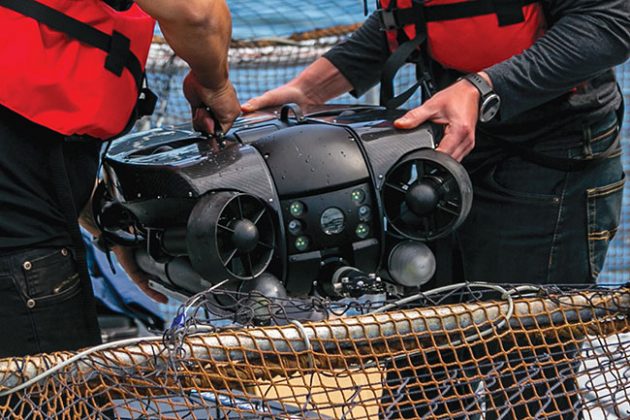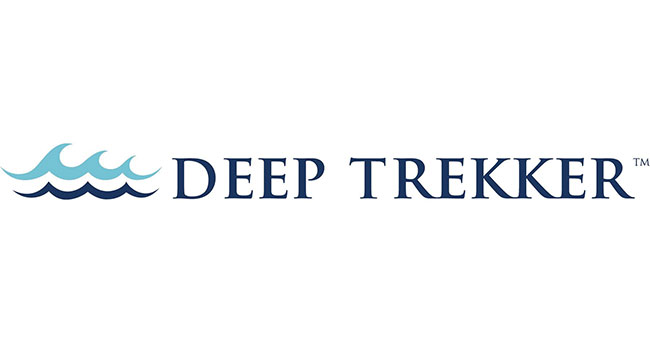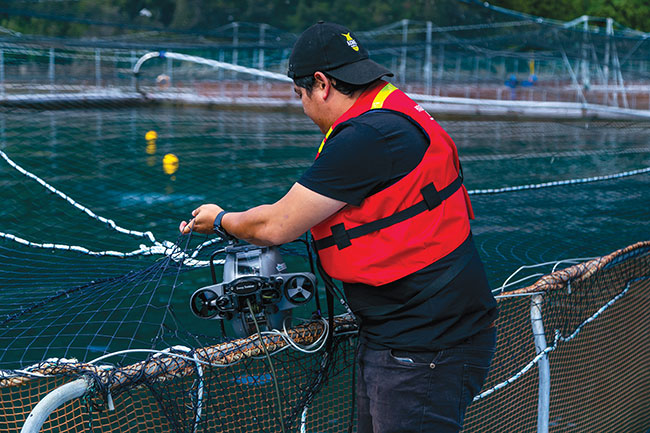
With total annual aquaculture production rapidly approaching 50% of the world’s seafood production, the importance of aquaculture on the global food market cannot be overstated. As with any food resource, sustainability and animal welfare ought to be top priorities. Keeping infrastructure and equipment in proper operating condition and ensuring compliance with health and welfare standards are of paramount importance to Deep Trekker.
A safe, cost-effective and straightforward alternative to commercial and staff divers, Deep Trekker Remotely Operated Vehicles (ROVs) provide operators with a reliable way to perform a wide variety of tasks around the farm.
Feed Monitoring
The use of a submersible ROV provides operators with a straightforward and reliable way to monitor their feeding practices to ensure that all fish receive the food necessary for optimal health. Feeding to satiation is a very common practice, but it only allows you to see when fish at the surface have fed adequately. Weaker or smaller fish below the surface may not be able to compete for feed at the surface and by the time feed has reached them it may be minimal, or it could have floated out of the pen entirely. By observing feeding practices with an ROV, teams can accurately evaluate their feeding procedures.
Net Health
With an ROV, operators can easily make net inspections a part of their daily routine to monitor the daily wear and tear that can cause fish escapes and pest incursions. In addition to keeping divers out of dangerous situations the use of an ROV for net inspections allows teams to maximize both their budget and time. Divers don’t have to be scheduled and travel long distances when an ROV can be deployed in minutes to check on nets and lines.
Sampling
An ROV is convenient for conducting the tests necessary to monitor fish health. Water and sediment samples, for instance, are a regular part of farm operations. Modular add-ons such as sediment scoops and water samplers allow for quick and accurate testing.
ROVs can also be used to monitor environmental conditions, which have an immediate effect on fish health and welfare. Deep Trekker vehicles have built-in temperature, depth and oxygen sensors available plus add-on multiparameter sondes that can simultaneously carry up to four environmental sensors allowing pilots to get environmental profiles in minutes. An ROV, which is far less intrusive than divers, is a useful alternative to help assess fish health, while not meaningfully affecting cortisol levels.
Biosecurity
In this age of increased microbial risk, it’s important that tools can be easily decontaminated. Deep Trekker ROVs can be decontaminated with a variety of solutions, allowing users to move from farm-to-farm without dramatically raising the risk of bringing harmful microbes with them. This is especially useful if your ROV is shared between land-based facilities and sea sites.

Morts
There are a number of things that cause morts, many of them beyond our control. Mort uplift systems are useful, but most morts do not end up being automatically uplifted and need to be pushed to the system. Deep Trekker ROV systems can be outfitted with mort pushers to allow pilots to bring morts directly into the uplift system. By using an ROV instead of divers, risk is minimized and morts are removed in a timely manner.
Budget
The use of an ROV has been proven to save farms significant amounts of money. The quick deployment and easy portability of Deep Trekker ROVs allow farms to use a submersible vehicle for smaller tasks that would otherwise require a dive team to complete.
The consistent inspections that are completed with an ROV allow teams to stay on top of potential issues around the farm. By catching potential problems early, before they become catastrophes, teams are able to prevent major losses.
In short, the use of an ROV is incredibly beneficial for a fish farm. Deep Trekker is proud to offer a variety of submersible robotic solutions and aquaculture-specific tools. Our products provide operators with a safe and reliable way to perform a wide variety of husbandry tasks around the farm. With a Deep Trekker ROV, operators can get eyes underwater quickly and easily.
Deep Trekker offers two different submersible ROVs: the DTG3 and the REVOLUTION, both of which are perfect for convenient and efficient underwater inspections and fish monitoring. The DTG3 is a mini observation-class vehicle built to provide operators with the ability to deploy in 30 seconds or less. The REVOLUTION is a completely reimagined vehicle with greater payload capabilities, deeper depths and advanced stabilization. The DTPod submersible camera is ideal for permanent installation and around-the-clock monitoring.
The entire Deep Trekker team is committed to ensuring that all of our aquaculture customers have the best submersible equipment on site at all times. We strongly believe that aquaculture has the potential to change the world in profoundly positive ways and we are determined to continue to contribute in any way we can. Please contact Deep Trekker today to discuss the benefits of using an ROV on your farm.
1-519-342-3177 • sales@deeptrekker.com • deeptrekker.com
Advertisement
- Five trends driving interest in open ocean aquaculture
- Boutique farm finds its niche in South Carolina







